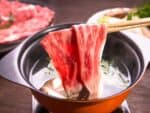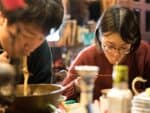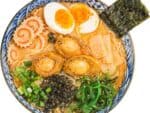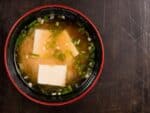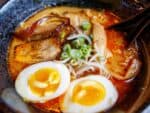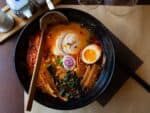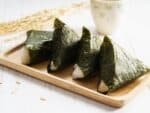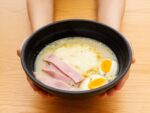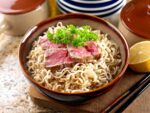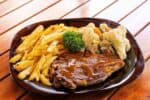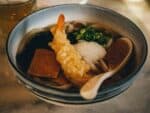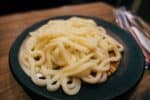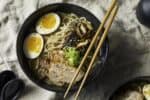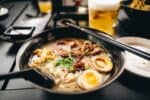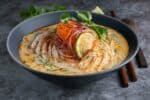Whether you want to try something new at home, or you’re looking for recommendations in Japan over winter, Nabemono is one dish that is certainly worth trying.
So what is Nabemono? Nabemono is a Japanese hotpot dish served with vegetables and meat. Nabemono can be cooked in a large pot, or fondue style in smaller pots at each table. Nabemono dishes are really simple and consist of a mixture of meat, fresh vegetables, seafood, tofu, and seasonal ingredients cooked in a bubbling soup broth.


Nabemono is a compound word with nabe meaning cooking pot and mono meaning stuff. Simply put nabemono is just food in a pot.
The winter months can be long and hard, this lovingly created dish is the perfect remedy to that. Learn more about this heart (and body) warming dish to prepare for winter.
Here’s my guide on: Making Nabemono At Home.
How Do You Make Nabemono?
Making this couldn’t be similar. The name really gives it away. Nabemono is a compound word with nabe meaning cooking pot and mono meaning stuff. Simply put nabemono is just food in a pot.
There’s nothing more wholesome than on a rainy winter’s day in Japan than coming home to a bowl of nabemono. This wintertime favorite is a staple in the home and restaurants throughout the country.
It is quick and easy to put together and incredibly filling. Full of fresh food, this is a nourishing meal that’s perfect for the cold weather.
To make nabemono you need to consider the tools you are using. Traditionally nabemono would be made at the table with family or guests. To facilitate this a portable gas or electric stove would be used.
It’s not compulsory that it be made at the table but in Japan, they treat eating as an experience to be enjoyed. If it can include the cooking, then it will!
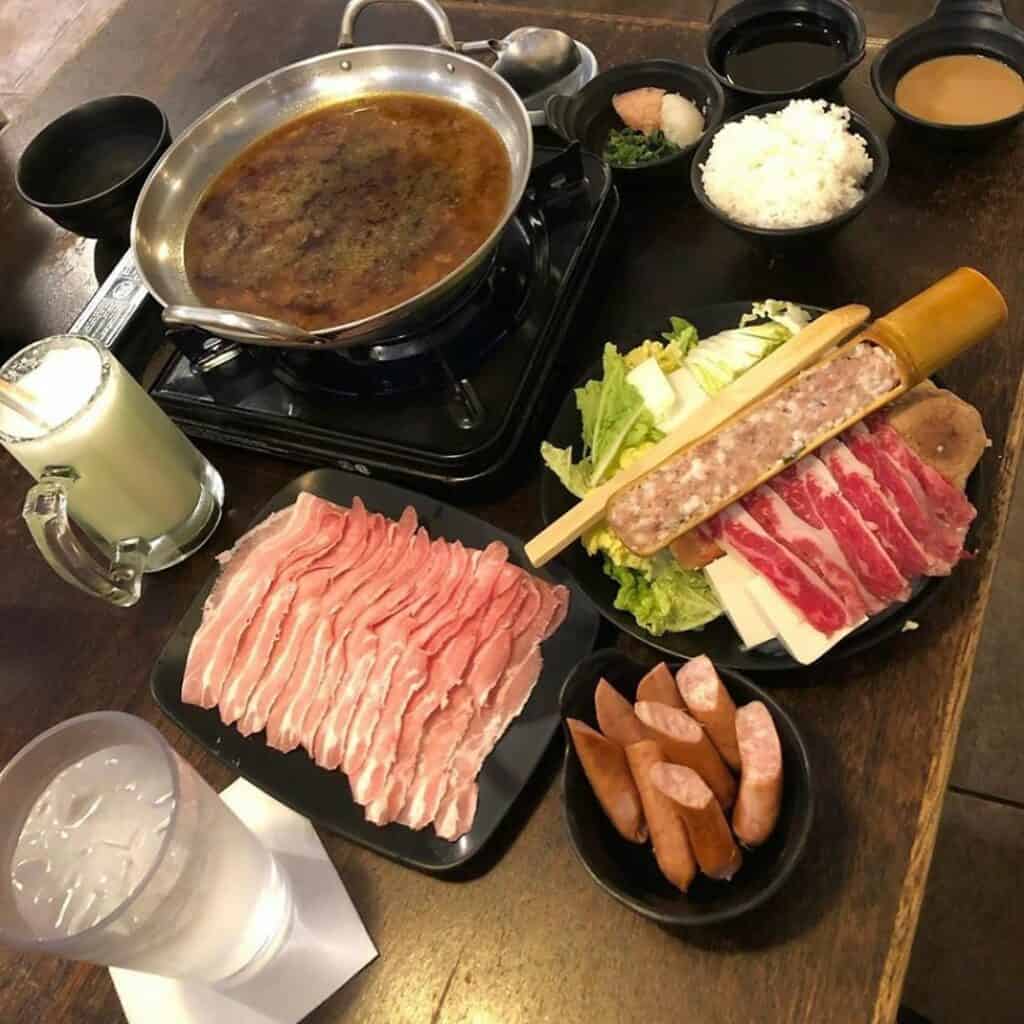
When considering the cooking pot, the donabe pot is favored for cooking nabemono. This is a thick ceramic bowl which means it’s perfect for retaining heat. The donabe pot was specifically designed as a cooking pot, so it is perfect for the job.
Nabemono would be eaten with chopsticks, as is customary in Japan. Chopsticks are used to eat all of the solid foods before you lift the bowl to drink the remaining soup.
You can have a wide variety of ingredients for your nabemono. Fish, seafood, meat, vegetables – all fresh. You can also add noodles, mushrooms, tofu, whatever is in the fridge.
Be careful to cook in the appropriate order. The first things that should go in are the items that will inform the flavor of the broth. Think meat and fish.
Following on, put in the ingredients that take longer to cook through, potatoes or carrots. Then you can add in items that will soak up the flavors and finally any thin meats or vegetables.
Of course, if you want seconds or even thirds more food can be added to the pot. Before adding new ingredients make sure the previous batch has been claimed.
Nabemono Etiquette
Japan is home to a very polite society, there are certain things to remember when dining in Japan. It’s worth taking your time to familiarise yourself with their customs before accidentally offending someone.
Nabemono is a social experience, especially if it is being prepared at the table. When dealing with shared food it is polite to use the opposite end of your chopsticks while moving food. You can also use a dedicated set of chopsticks.
If you are dining as a group it will be your responsibility to cook your own food. As such you should make sure that you only cook the food you want to eat yourself.
Likewise, if you see a tender piece of chicken or some pork belly in the broth, only take it out if it’s yours. There should be plenty to go around so if something does look particularly tasty, you can add more in.
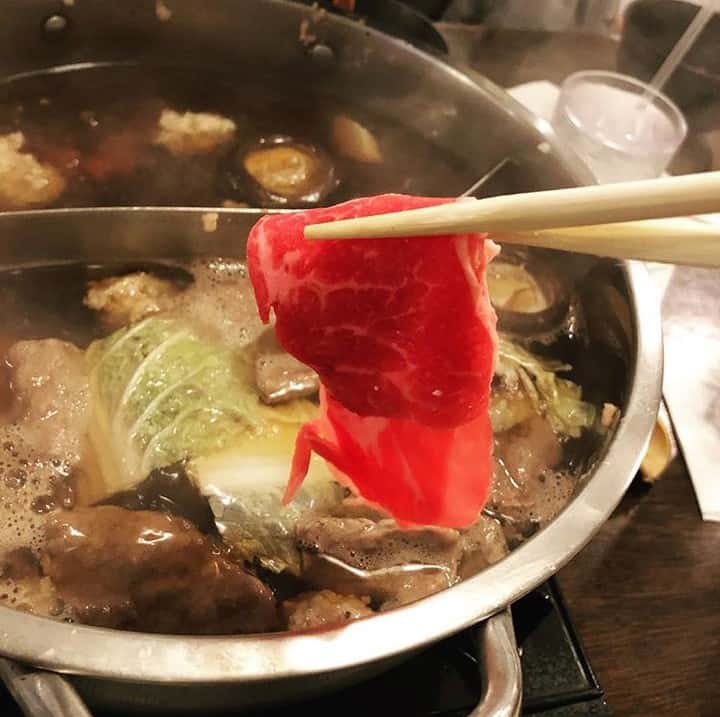
When you want to add more food in, make sure that the pot is boiling before adding anything. Be courteous and check if anyone else is cooking something, particularly meat. As soon as you add ingredients it will cool the broth down.
These are only things to consider when dining with guests. if you happen to be cooking for one then you can do as you please.
As nabemono can be a social occasion, it would only make sense that the drinks flow as well. In Japan, it is customary to eat while you drink, so nabemono is the perfect dish for the occasion.
Sake (rice wine) can be served with nabemono but also beer has become a popular drink choice. Non-alcoholic options would include soft drinks, non-alcoholic beer, and tea.
Where Can You Find Nabemono?
If you wanted to teach yourself some traditional Japanese dishes nabemono would be a great place to start. There is such a small learning curve involved and the end result is guaranteed to be delicious.
If you’re visiting Japan and wanted to know where you can sample some nabemono, then you will be spoilt for choice. Nabemono is a common dish served in Japanese restaurants and gastro pubs called izakaya.
As the primary focus of izakaya is drinking, it’s a great social setting to meet up with your friends! Ice cold beers and heartwarming nabemono is the perfect evening combination on cold winter nights.
From Tokyo to Osaka, Nagoya to Sendai nabemono is a tasty meal offered in urban and rural Japan alike. If you are visiting Japan over the winter months try nabemono all over. Local nabe will differ, with local ingredients and flavors.
No two nabemono needs to be the same. Not should it be, there are a variety of ingredients that can be used for nabemono, it’s the perfect excuse to be adventurous.
Nabemono is also the perfect dish to serve at dinner parties. It takes a lot of pressure off of you as the host. Nabemono is incredibly versatile that you customize for the occasion.
Whether you are cooking for a date night, a business meeting, or for friends, nabemono will be the highlight of the night. As a host, you will prepare the ingredients before, which can be made up of the ingredients in the house.
Look for things like vegetables, meat, fish, or tofu. Add some rice noodles, or udon, or anything that’s lying around. Similar to fondue, your guests should be encouraged to help themselves.
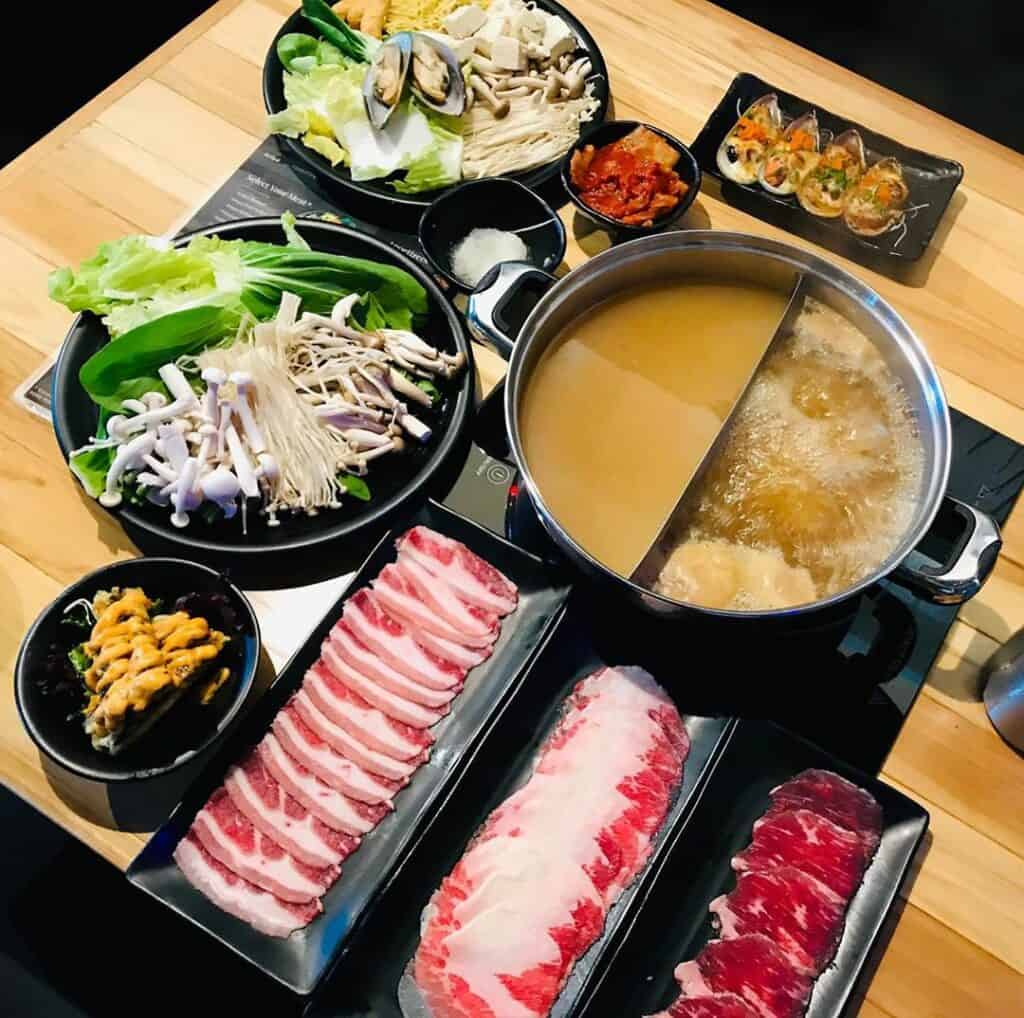
When setting up your table you will place the fresh ingredients on a serving plate surrounding your cooking pot. Prepare the ingredients in a bite-size fashion so that they are ready to go. This also means that the food will cook quickly.
As host nabemono will allow you to enjoy your night fully, in the company of your guests. Everyone will be encouraged to eat as much as they like. You will prepare the soup broth in advance, but the rest of the cooking will be shared among your guests.
There will be a sense of camaraderie among you and your friends as you eat flavorsome and delicious food. Secretly, everyone will feel even more satisfied having cooked their own.
Be sure to serve plenty of alcohol as well, unless any guest doesn’t partake. This is a collective experience, a wonderful social gathering and everyone should be encouraged to let loose.
The cleanup will also be quite simple, after all everything was cooked in a single pot. Nabemono is a terrific dish to serve at your party.
Are There Different Types of Nabemono?
This dish can be made up of elements you have in the fridge or pantry. It might surprise you to know there are some traditional recipes. Different restaurants or izakayas will make nabemono differently.
This is also true of different regions of Japan. Depending on where you are in Japan the ingredients will differ. One thing is for sure though, it’s always full of flavor and mouthwateringly my delicious.
The first thing to note is the soup broth. This can actually be prepared in a number of different ways.
Firstly, you may have a lightly flavored stock such a kale broth known as kombu. Secondly, you might prefer a stronger flavor stock made with miso, dashi, or soy sauce.
These may be the most common but sweet soy flavors can be used as well. There is also the option of unflavoured. Relying on the ingredients you’ve prepared to eat to supply flavor to the broth.
Chankonabe
There is a wide-ranging variety of different nabemono that can be prepared. Some of which have very specific purposes, such as Chankonabe. This particular type of nabemono was created and eaten by a specific type of sportsman.
Sumo wrestlers in Japan are known for their incredible mass. Sumo is an old Japanese sport that predates the 12th century. Known for their considerable mass, Sumo wrestlers way in excessive 150 kilograms (330 pounds)
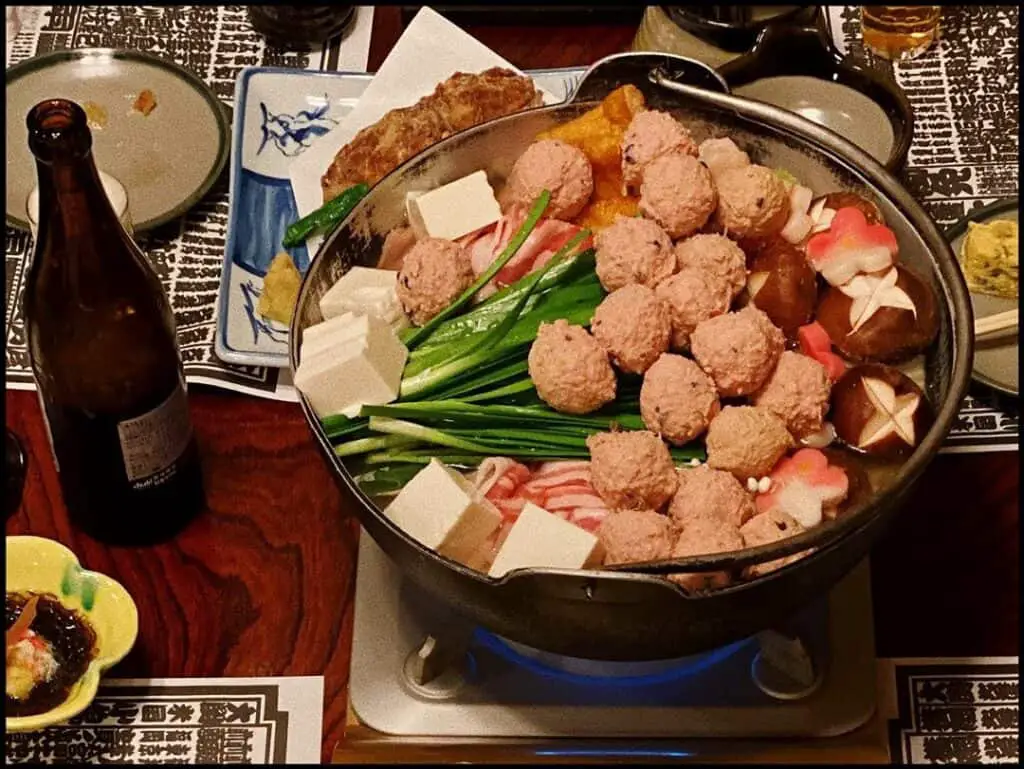
They consume up to 20,000 calories a day to reach and maintain this bodyweight. One way they achieve that is by feasting on chankonabe.
Chankonabe is prepared with more ingredients than typical nabemono. This is to help the sumo wrestlers gain weight. It used to be that only sumo wrestlers ate this dish.
However, chankonabe is now a popular meal served in restaurants, particularly ones operated by retired sumo wrestlers. The first restaurant to serve the dish was opened in the Ryōgoku district of Tokyo. Which was the prime location for sumo stables in the city.
When chankonabe is served during a sumo tournament, the nabe will be made with only chicken. The idea for this comes from the thought that a wrestler should always be on two legs. Serving beef or pork wouldn’t work as cows and pigs walk on all fours.
Motsunabe
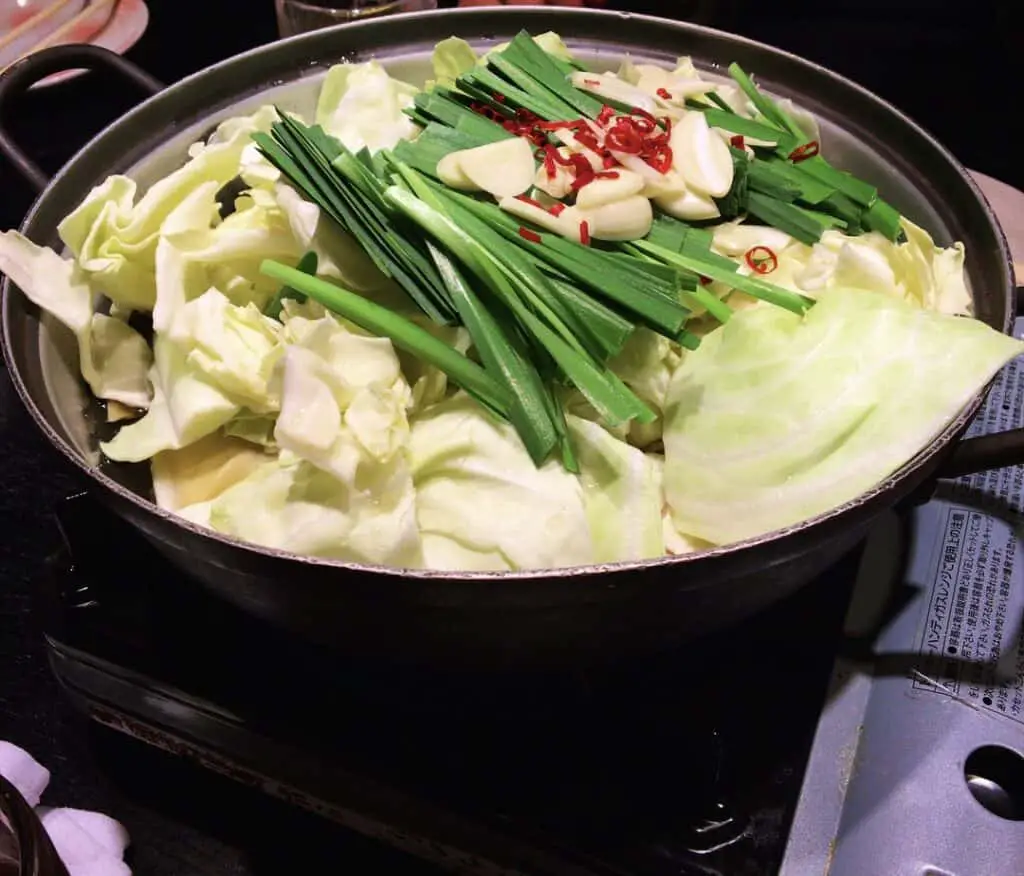
A dish that originated in Fukuoka called Motsunabe was popularised throughout Japan during the 1990s. This dish is known for its taste but also it is well priced.
For this dish, you would use a stronger broth with either miso or soy sauce. But the main ingredient here is beef or pork offal. Offal is the animal’s viscera and entrails, their organ meats.
It would also likely be boiled with cabbage and garlic chives to help flavor the broth. This is a great dish to enjoy with alcohol. It is still a very popular dish in Fukuoka and the Kansai area has a very similar dish called horumonyaki made with offal.
In the Kantō region and in Tokyo, the dish turned out to be a fad and it is no longer popular. Other types of nabe can be found all over these areas, however.
Shabu-shabu
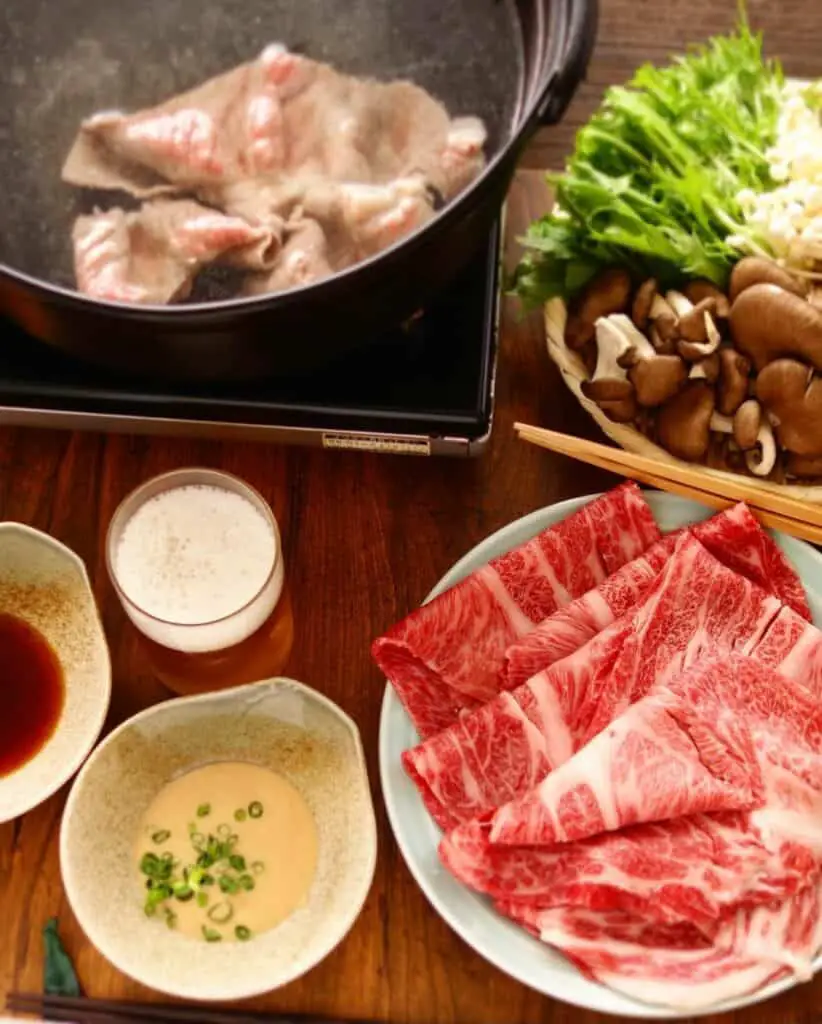
This dish is named for the sound it makes when the ingredients in the pot are stirred. Loosely translated to “swish-swish.” Shabu-shabu is a type of nabemono hotpot that would be served with a variety of dipping sauces.
Shabu-shabu is a relatively new addition to Japanese hotpots but is nonetheless very popular. It originates from a restaurant called Suehiro in Osaka. The origins of the dish can actually be found in the Chinese hotpot known as Shuàn Yángròu.
Shabu-shabu is very popular outside of Japan, particularly in local Japanese neighborhoods throughout the United States and Canada. These “Little Tokyos” as they are known, can be found in cities across the two countries.
What separates shabu-shabu from other nabemono is that it will be predominately made up of thin slices of meat and vegetables. The broth will be made to be more savory rather than sweet.
Lots of different sauces can be prepared, which will be placed by the pot. Including, sesame sauce, ponzu, soy sauce, and a selection of deconstructed items so the guest may prepare their own.
Sukiyaki
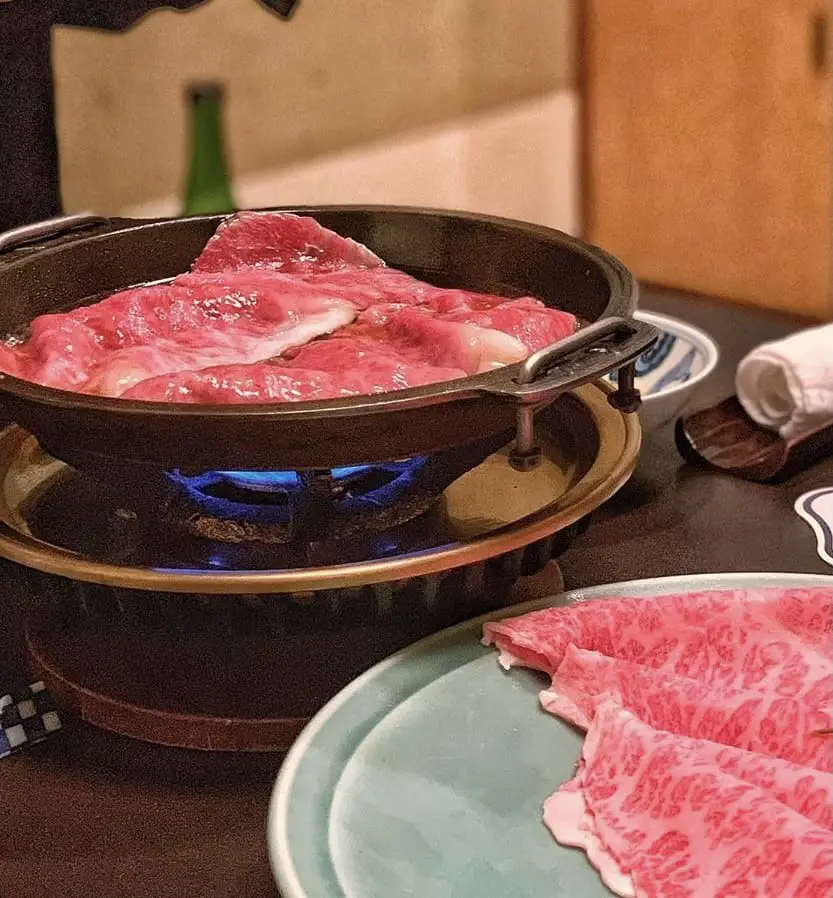
Sukiyaki has been around a while longer than shabu-shabu. Dating back to the Meiji era (1868-1912) the dish became a traditional Japanese dish.
This type of nabemono is usually prepared with thinly sliced beef. However, some parts of the country like Niigata prefer to use pork.
There are two distinct ways of preparing this dish that have been developed by different regions of Japan. There is the Kantō style from eastern Japan and the Kansai style from western Japan.
With the Kantō style, you would flavor the broth first with dashi, sake, sugar, mirin, and soy sauce. After heating in the pot for a while, the meat, vegetables, and other ingredients can be added.
With Kansai style, this process is almost flipped. Meat will be added into the pot first. Once the meat is almost cooked you flavor the pot with sugar, sake, and soy sauce before adding in the vegetables.
Oden
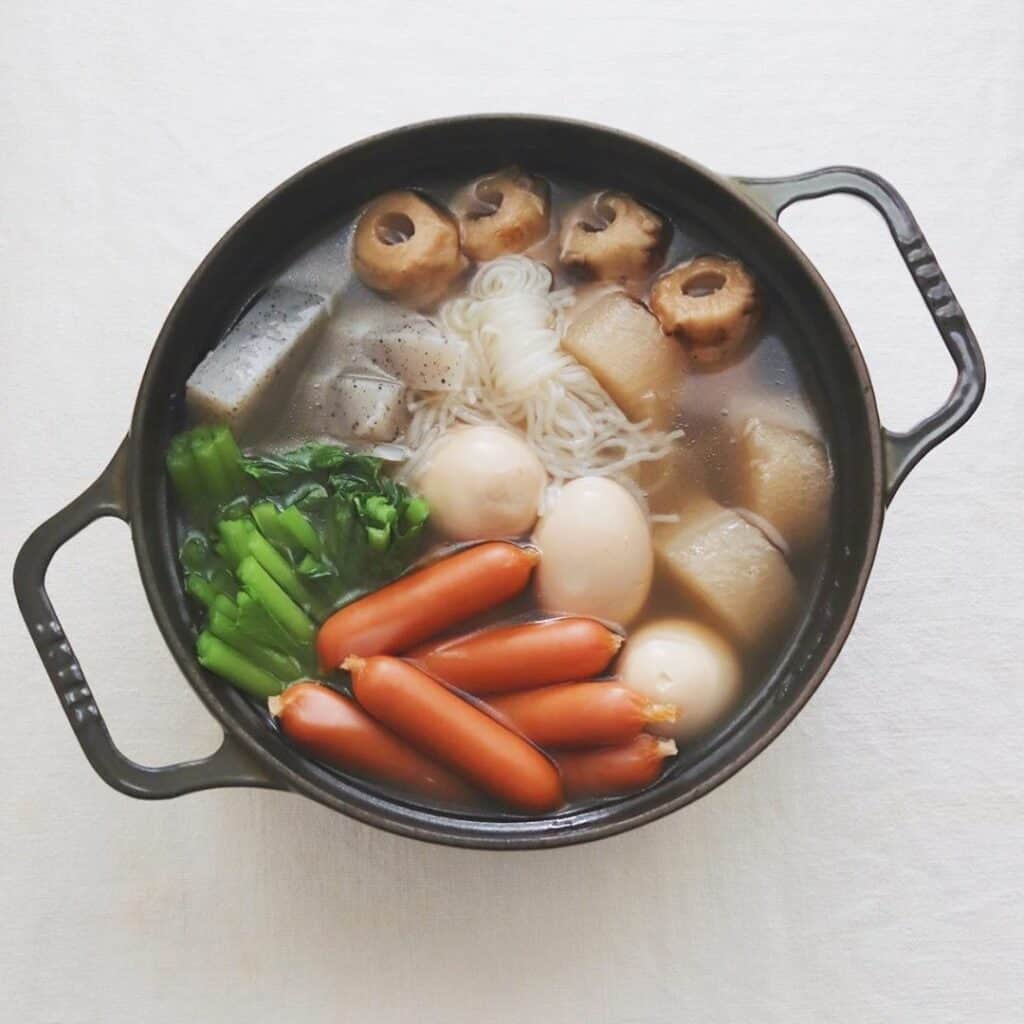
Oden is another type of nabemono hotpot that is very popular. This dish is usually prepared in a soy-based dashi broth and contains eggs. This dish is also commonly served with Karashi (Japanese mustard) as a condiment.
Nabemono, including oden, is typically a winter food. Oden, however, is offered all year by some restaurants and carts. Many different variations of this dish are sold, including single ingredients.
From as little as 100 yen (less than a dollar), Oden is a great choice for people on a budget. This dish can be made with eggs, fishcakes, konjac, and daikon.
Interestingly, many restaurants will keep their oden broth as a master stock. They will replenish the stock as it simmers so that the flavors can develop over months or years.
Nabemono is the Perfect Winter Recipe
Whether you want to try something new at home, or you’re looking for recommendations in Japan over winter. Nabemono is one dish that is certainly worth trying.
Sitting with friends and family around the simmering donabe pot, fresh vegetables and meat surround it. You can mix and match and try new things.
This dish is sold all over Japan and will differ from region to region, rural and urban. It’s the perfect dish to try to help beat the cold.
If you’re looking for something exciting to cook for your next dinner party, you can’t go wrong with nabemono. It will be easy to prepare for you as the host, and easy to clean up afterward.
Not to mention it will make you very popular among your guests. It will be a meal to remember, and you can make the broth to your preference.
You can make the kale based kombu broth or warishita. Warishita is a mixture of mirin, sake, sugar, soy sauce, and dashi. You can customize the broth to be sweet or savory.
Nabemono is a highly customizable dish and you should feel encouraged to try and experiment. It’s even perfect for people trying to gain weight. By cooking a batch of chankonabe and filling up just like a sumo wrestler.
Since this dish is made with fresh meat and fresh vegetables you can guarantee that it will be a healthy meal. It’s also perfect for the end of the week when you need to use up the food in the refrigerator.
You may not have a gas stove at home right now and that’s fine. Nabemono can be in a pot you have on the stove. But when you decide to make this your next dinner party menu, make sure to invest and cook at the table!
